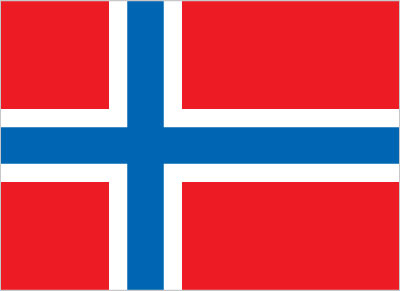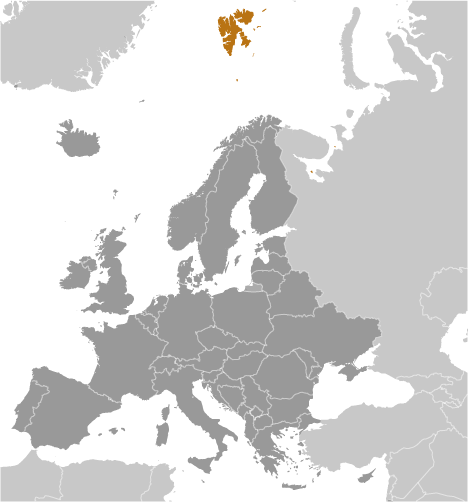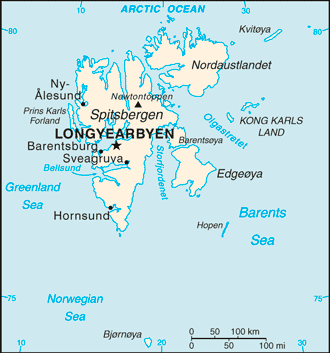


-
Introduction :: Svalbard
-
Background:The archipelago may have been first discovered by Norse explorers in the 12th century; the islands served as an international whaling base during the 17th and 18th centuries. Norway's sovereignty was internationally recognized by treaty in 1920, and five years later it officially took over the territory. In the 20th century coal mining started and today a Norwegian and a Russian company are still functioning. Travel between the settlements is accomplished with snowmobiles, aircraft, and boats.
-
Geography :: Svalbard
-
Location:Northern Europe, islands between the Arctic Ocean, Barents Sea, Greenland Sea, and Norwegian Sea, north of NorwayGeographic coordinates:78 00 N, 20 00 EMap references:Arctic RegionArea:total: 62,045 sq kmland: 62,045 sq kmwater: 0 sq km
note: includes Spitsbergen and Bjornoya (Bear Island)
country comparison to the world: 126Area - comparative:slightly smaller than West VirginiaLand boundaries:0 kmCoastline:3,587 kmMaritime claims:territorial sea: 12 nmcontiguous zone: 24 nmcontinental shelf: extends to depth of exploitationexclusive fishing zone: 200 nmClimate:arctic, tempered by warm North Atlantic Current; cool summers, cold winters; North Atlantic Current flows along west and north coasts of Spitsbergen, keeping water open and navigable most of the yearTerrain:rugged mountains; much of the upland areas are ice covered; west coast clear of ice about half the year; fjords along west and north coastsElevation:lowest point: Arctic Ocean 0 mhighest point: Newtontoppen 1,717 mNatural resources:coal, iron ore, copper, zinc, phosphate, wildlife, fishLand use:agricultural land: 0% (2011 est.)arable land: 0% (2011 est.) / permanent crops: 0% (2011 est.) / permanent pasture: 0% (2011 est.)forest: 0% (2011 est.)other: 100% (2011 est.)Population distribution:the small population is primarily concentrated on the island of Spitsbergen in a handful of settlements on the south side of the Isfjorden, with Longyearbyen being the largestNatural hazards:ice floes often block the entrance to Bellsund (a transit point for coal export) on the west coast and occasionally make parts of the northeastern coast inaccessible to maritime trafficEnvironment - current issues:ice floes are a maritime hazard; past exploitation of mammal species (whale, seal, walrus, and polar bear) severely depleted the populations, but a gradual recovery seems to be occurringGeography - note:northernmost part of the Kingdom of Norway; consists of nine main islands; glaciers and snowfields cover 60% of the total area; Spitsbergen Island is the site of the Svalbard Global Seed Vault, a seed repository established by the Global Crop Diversity Trust and the Norwegian Government -
People and Society :: Svalbard
-
Population:2,583 (July 2017 est.)country comparison to the world: 230Ethnic groups:Norwegian 58%, foreign population 42% (consists primarily of Russians, Thais, Swedes, Filipinos, and Ukrainians) (2019 est.)note: foreigners account for almost one third of the population of the Norwegian settlements, Longyearbyen and Ny-Alesund (where the majority of Svalbard's resident population lives), as of mid-2019Languages:Norwegian, RussianPopulation growth rate:-0.03% (2014 est.)country comparison to the world: 198Population distribution:the small population is primarily concentrated on the island of Spitsbergen in a handful of settlements on the south side of the Isfjorden, with Longyearbyen being the largestSex ratio:NAInfant mortality rate:total: NA (2018)male: NAfemale: NALife expectancy at birth:total population: NA (2017 est.)male: NAfemale: NATotal fertility rate:NAEducation expenditures:NA
-
Government :: Svalbard
-
Country name:conventional long form: noneconventional short form: Svalbard (sometimes referred to as Spitsbergen, the largest island in the archipelago)etymology: 12th century Norse accounts speak of the discovery of a "Svalbard" - literally "cold shores" - but they may have referred to Jan Mayen Island or eastern Greenland; the archipelago was traditionally known as Spitsbergen, but Norway renamed it Svalbard in the 1920s when it assumed sovereignty of the islandsDependency status:territory of Norway; administered by the Polar Department of the Ministry of Justice, through a governor (sysselmann) residing in Longyearbyen, Spitsbergen; by treaty (9 February 1920), sovereignty was awarded to NorwayGovernment type:non-self-governing territory of NorwayCapital:name: Longyearbyengeographic coordinates: 78 13 N, 15 38 Etime difference: UTC+1 (6 hours ahead of Washington, DC, during Standard Time)daylight saving time: +1hr, begins last Sunday in March; ends last Sunday in Octoberetymology: the name in Norwegian means Longyear Town; the site was established by and named after John LONGYEAR, whose Arctic Coal Company began mining operations there in 1906Independence:none (territory of Norway)Legal system:the laws of Norway where applicable apply; only the laws of Norway made explicitly applicable to Svalbard have effect there; the Svalbard Act and the Svalbard Environmental Protection Act, and certain regulations, apply only to Svalbard; the Spitsbergen Treaty and the Svalbard Treaty grant certain rights to citizens and corporations of signatory nations; as of June 2017, 45 nations had ratified the Svalbard TreatyCitizenship:see NorwayExecutive branch:chief of state: King HARALD V of Norway (since 17 January 1991); Heir Apparent Crown Prince Haakon MAGNUS (son of the king, born 20 July 1973)head of government: Governor Kjerstin ASKHOLT (since 1 October 2015); Assistant Governor Berit SAGFOSSEN (since 1 April 2016)elections/appointments: none; the monarchy is hereditary; governor and assistant governor responsible to the Polar Department of the Ministry of JusticeLegislative branch:description: unicameral Longyearbyen Community Council (15 seats; members directly elected by majority vote to serve 4-year-terms); note - the Council acts very much like a Norwegian municipality, responsible for infrastructure and utilities, including power, land-use and community planning, education, and child welfare; however, healthcare services are provided by the stateelections: last held on 6 October 2015 (next to be held in October 2019)election results: seats by party - Conservatives 5, Labor Party 5, Liberals 3, Green Party 2; composition - men 10, women 5, percent of women 33.3%Judicial branch:none; note - Svalbard is subordinate to Norway's Nord-Troms District Court and Halogaland Court of Appeal, both located in TromsoPolitical parties and leaders:Svalbard Conservative Party [Kjetil FIGENSCHOU]
Svalbard Green Party [Helga Bardsdatter KRISTIANSEN, Espen Klungseth ROTEVATN]
Svalbard Labor Party [Elise STROMSENG]
Svalbard Liberal Party [Erik BERGER]International organization participation:noneFlag description:the flag of Norway is usedNational anthem:note: as a territory of Norway, "Ja, vi elsker dette landet" is official (see Norway)
-
Economy :: Svalbard
-
Economy - overview:
Coal mining, tourism, and international research are Svalbard's major industries. Coal mining has historically been the dominant economic activity, and the Spitzbergen Treaty of 9 February 1920 gives the 45 countries that so far have ratified the treaty equal rights to exploit mineral deposits, subject to Norwegian regulation. Although US, UK, Dutch, and Swedish coal companies have mined in the past, the only companies still engaging in this are Norwegian and Russian. Low coal prices have forced the Norwegian coal company, Store Norske Spitsbergen Kulkompani, to close one of its two mines and to considerably reduce the activity of the other. Since the 1990s, the tourism and hospitality industry has grown rapidly, and Svalbard now receives 60,000 visitors annually.
The settlements on Svalbard were established as company towns, and at their height in the 1950s, the Norwegian state-owned coal company supported nearly 1,000 jobs. Today, only about 300 people work in the mining industry.
Goods such as alcohol, tobacco, and vehicles, normally highly taxed on mainland Norway, are considerably cheaper in Svalbard in an effort by the Norwegian Government to entice more people to live on the Arctic archipelago. By law, Norway collects only enough taxes to pay for the needs of the local government; none of tax proceeds go to the central government.
GDP - real growth rate:NA
Labor force:1,590 (2013)country comparison to the world: 228Budget:revenues: NAexpenditures: NATaxes and other revenues:NABudget surplus (+) or deficit (-):NAExports:NA
Imports:$NA
Exchange rates:Norwegian kroner (NOK) per US dollar -8.308 (2017 est.)8.0646 (2016 est.)8.0646 (2015)8.0646 (2014 est.)6.3021 (2013 est.) -
Energy :: Svalbard
-
Crude oil - production:194,300 bbl/day (2014 est.)country comparison to the world: 36Crude oil - exports:16,070 bbl/day (2012 est.)country comparison to the world: 53Crude oil - imports:0 bbl/day (2012 est.)country comparison to the world: 200Refined petroleum products - consumption:80,250 bbl/day (2013 est.)country comparison to the world: 87Refined petroleum products - exports:4,488 bbl/day (2012 est.)country comparison to the world: 93Refined petroleum products - imports:18,600 bbl/day (2012 est.)country comparison to the world: 127Natural gas - production:0 cu m (2013 est.)country comparison to the world: 203Natural gas - consumption:0 cu m (2013 est.)country comparison to the world: 204Natural gas - exports:0 cu m (2013 est.)country comparison to the world: 192Natural gas - imports:0 cu m (2013 est.)country comparison to the world: 195
-
Communications :: Svalbard
-
Telephone system:general assessment: modern, well-developed (2018)domestic: the Svalbard Satellite Station - connected to the mainland via the Svalbard Undersea Cable System - is the only Arctic ground station that can see low-altitude, polar-orbiting satellites; it provides ground services to more satellites than any other facility in the world (2018)international: country code - 47-790; the Svalbard Undersea Cable System is a twin communications cable that connects Svalbard to mainland Norway; the system is the sole telecommunications link to the archipelago (2019)Broadcast media:the Norwegian Broadcasting Corporation (NRK) began direct TV transmission to Svalbard via satellite in 1984; Longyearbyen households have access to 3 NRK radio and 2 TV stationsInternet country code:.sj
-
Military and Security :: Svalbard
-
Military and security forces:no regular military forces; military installations prohibited by treatyMilitary - note:Svalbard is a territory of Norway, demilitarized by treaty on 9 February 1920; Norwegian military activity is limited to fisheries surveillance by the Norwegian Coast Guard
-
Transportation :: Svalbard
-
Airports:4 (2013)country comparison to the world: 190Airports - with paved runways:total: 1 (2013)2,438 to 3,047 m: 1 (2013)Airports - with unpaved runways:total: 3 (2013)under 914 m: 3 (2013)Heliports:1 (2013)Ports and terminals:major seaport(s): Barentsburg, Longyearbyen, Ny-Alesund, Pyramiden
-
Transnational Issues :: Svalbard
-
Disputes - international:
despite recent discussions, Russia and Norway dispute their maritime limits in the Barents Sea and Russia's fishing rights beyond Svalbard's territorial limits within the Svalbard Treaty zone